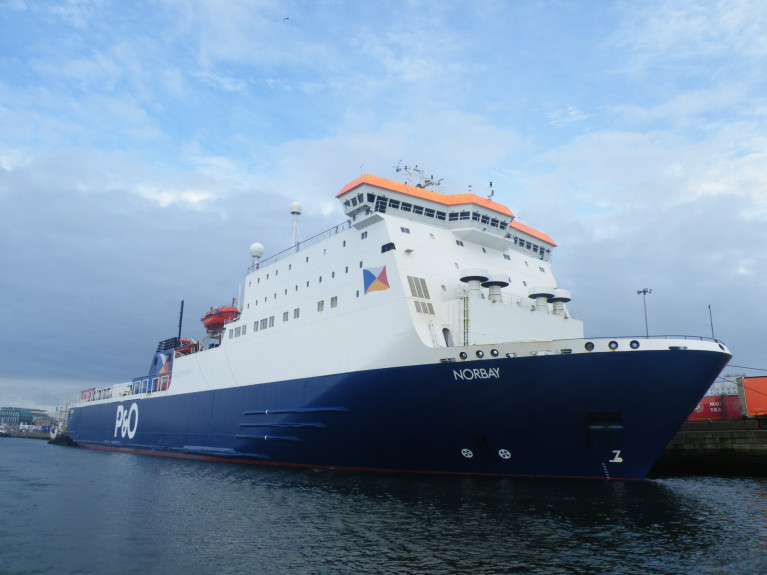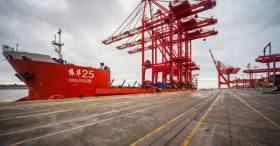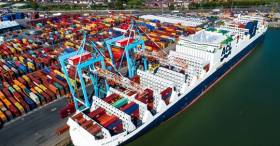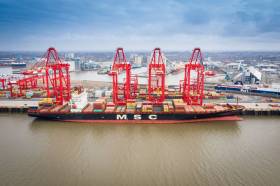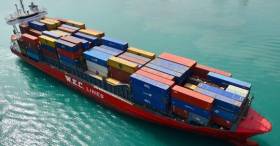Displaying items by tag: Port of Liverpool
Port of Liverpool Extends Steel Terminal as Peel Ports Group Deal with Growth in Demand
At the Port of Liverpool, part of the Peel Ports Group, is to extend its steel and metals terminal in response to strong growth in customer demand at the north-west England port.
The UK’s second largest port operator began construction of the 20,000 square foot extended warehouse at its North 3 Canada Dock earlier this year
The group’s investment comes as the Port of Liverpool enjoyed one of its busiest months for steel volumes in September, with more than 75,000 tonnes handled by staff across the port and Birkenhead Docks.
It is the port’s busiest month for steel in more than two years, when 93,000 tonnes were handled at the site in July 2021.
An initial 8,000 square foot of the newly created warehouse space is already in use, with a second phase of construction work to build an extra 12,000 square foot of the terminal ongoing and will be completed in December.
Phil Hall, Mersey Ports Director at Peel Ports Group said: “We’re really pleased to have seen such an increase in demand for steel handling at our port in recent months.
“This positive news led to us choosing to increase the size of our facility, which offers customers the chance to expand their capacity, as well as improving our handling facilities at the port.
“Given the benefits of the Port of Liverpool’s central location, and its proximity to UK manufacturing sites, we believe this will be a very important and worthwhile investment.”
The site now has 280,000 square foot of internal storage, as well as 100,000 square foot of external footage. It also has a total throughput capacity of in excess of 600,000 tonnes annually.
The facility was once the UK’s first fully-automated steel terminal following a £9m upgrade in 2016.
Real time stock availability, precision coil selection and a vehicle booking system has minimised back office processing and paperwork, handling, as well as haulier turn-around time since its completion.
Redundancies at Port of Liverpool of Up to 125 Staff Announces UK's Second Largest Port Operator
Across the Irish Sea at the Port Port of Liverpool is where up to 125 people could lose their jobs following a "sustained and significant deterioration" in the number of containers coming in and out of the terminals on Merseyside.
The UK’s second largest ports operator, Peel Ports Group announced that formal consultation notices will be issued at the container terminal on last Friday, September 22, following talks with union representatives. The load on load off (lo-lo) terminal employs approximately 850 staff.
A consultation process is expected to take around 45 days, with the possibility of up to 125 redundancies at the north-west England port.
According to management at Peel Ports, their decision was “extremely regrettable but unavoidable”, adding, “where possible, every effort will be made to redeploy affected staff to alternative roles within the business.”
More from Liverpool Echo on the industrial dispute at the port where there was a drop in UK container volumes estimated to be around 12% during the first half of 2023. This drop follows a 7% decline in 2022.
UK Port Operator Welcomes Eco-Friendly Dredging Vessel Working in Liverpool and Glasgow
The UK's second largest port operator has welcomed a new energy efficient LNG dredger for the first time as it continues to improve the sustainability of its dredging work.
The Peel Ports Group has used Dutch marine contractor Van Oord’s groundbreaking Vox Apolonia for maintenance dredging of the Port of Liverpool and King George V Dock in Glasgow.
It is the first time the LNG trailing suction hopper dredger has been used at any of the group’s ports, and only the second time it has carried out work in the UK
.
The Vox Apolonia uses liquefied natural gas (LNG) and has a significantly lower carbon footprint than conventional trailing suction hopper dredgers. The use of LNG reduces nitrous oxide emissions by 90 per cent, as well as totally eliminating sulphur emissions.
Peel Ports Group – which is committed to being a net zero port operator by 2040 – first welcomed the vessel to the Port of Liverpool this month, before it carried out work in Glasgow, and returned for further work at its site in Liverpool.
At the same time, Van Oord also provided its new hybrid water-injection dredger Maas to the port, bunkered for the first time with a biofuel blend. The company estimates she currently emits 40 per cent less CO2e than her predecessor whilst dredging for the port group in Liverpool.
It comes as the firm supplied four separate vessels to carry out important dredging of the Liverpool channel and docks at the same time.
Garry Doyle, Group Harbour Master at Peel Ports Group, said; “We are always looking for ways to reduce our impact on the environment across our port estate. We are striving to become net zero across the group by 2040, and the Vox Apolonia is a step ahead in terms of its sustainability credentials.
“Maintenance dredging is vital to both support the functioning of our ports, and to provide a safe navigation for vessels passing through our waters.
“It’s important to us that we use methods that are as energy efficient as possible to do this work, and that’s why we chose the Vox Apolonia for this important project.”
Marine Bourgeois, Project Manager at Van Oord, said: “We're constantly researching and investing to bring our fleet to the next level in terms of sustainability. We have our own commitment to achieve net-zero emissions by 2050 and the Vox Apolonia is the next step towards that goal."
“It's been great to work with Peel Ports on this project. They are always open to collaborate in our initiatives to provide greener and more efficient dredging solutions. We are proud to bring our marine ingenuity in support of their goal to be net zero by 2040."
Maintenance dredging involves the removal of sediments that have built up in existing channels, berths, approaches, and associated swing basins. The work helps maintain a safe depth of water for vessels passing through its ports.
In the UK the Port of Liverpool has been ranked as the nation's top port for port-centric logistics potential according to a new industry study.
Property adviser Knight Frank analysed and ranked 41 UK ports based on 13 criteria, assessing their potential for future logistics investment and development, in its latest Future Gazing report.
The Port of Liverpool topped its table, after the port ranked first for forecast export growth and was placed in the top ten percent for access to consumer markets, skilled labour, availability of land, port capacity, import growth potential and size of the existing logistics market.
Peel Ports Group Commercial Director Stephen Carr said: ““We’ve long argued that the Port of Liverpool is one of the UK’s best-located ports, and we have built on that with significant investment over many years to create jobs and enable more efficient supply chains.
“These benefits have been greatly enhanced recently by confirmation from the Government that the Liverpool City Region has gained final Freeport status approval, meaning the benefits for supply chains locating to the region are even greater than ever”.
Knight Frank researched each port’s potential role in shortening supply chains and mitigating supply disruption.
Its report looked into 13 different categories including a port’s capacity, connectivity, as well as the overall investment at the site and import and export growth potential.
The Port of Liverpool received the highest overall score in its rankings.
Peel Ports has made significant investment at the port in recent years, building on the completion of Liverpool2 – a £400 million deep-water container terminal. The report also recognised the importance of the port’s grain terminal to the UK’s agri bulk industry.
The location of the port is of strategic importance to major importers and exporters of goods as it offers unrivalled connectivity to Ireland and access to a catchment area of over 35 million people.
Dock Workers in their Hundreds at Port of Liverpool Stage Fresh Strikes in Dispute Over Pay
Dock workers numbering almost 600 at the Port of Liverpool are taking part in another week of strike action after their demands for better wages and working conditions were not met.
As ITV News reports, they include port operatives and engineers, who began two weeks of strike action on 19 September as Afloat previously reported.
Unite said the port's dock masters, shift managers and vessel traffic services officers are also preparing to be balloted for strike action.
The workers' union said its members were angry at a pay offer of around 8.3% when inflation was in double figures.
Unite general secretary Sharon Graham said: “Peel Ports’ plan is to pile up even more profit at the expense of its workers and their families.
"These regurgitated, months-old plans are simply a desperate attempt to intimidate workers. It won’t work."
More here including a response from Peel Ports, the operator of the north-west England port on Merseyside.
P&O Detained Ferry Sets Sail after Furious £570,000 Liverpool Port Fees Row Resolved
A deadlock was today (yesterday) broken in a high-profile business bust-up which meant a detained ferry carrying key supplies back and forth across the Irish Sea (to Dublin Port) could leave Liverpool.
Top level talks have been ongoing since Thursday when the Liverpool Echo exclusively revealed how the Norbay, a P&O Ferries vessel was stranded in Seaforth.
It followed a dispute with Peel Ports, who own and administer the dock facilities of the Port of Liverpool, and who demanded a cheque for nearly £600,000 of what they claimed were outstanding fees.
P&O disagreed with that figure, believed it was two thirds that amount, and asked for flexibility to pay the bill at a time when they are losing many tens of thousands pounds a day in revenue due to the global pandemic lockdown.
The shipping company also added that their key contact at The Mersey Docks and Harbour Company had been furloughed without their knowledge, interrupting their communications.
Now, an agreement has been reached, allowing the Norbay to set sail for Ireland within the next few hours (last night), if necessary.
Afloat tracked this morning the Norbay which departed Dublin Port and is currently returning to Liverpool and from where Norbank is bound in the opposite direction.
Also tracked departing Dublin but on Sunday was the Norbank which arrived yesterday morning to the north Wales Port of Mostyn to carry out berthing trials as the Echo also reported that the company had hastily tried to pursue an alternative port.
At the Flintshire port was the pilot cutter Patrica in proximity of the ferry's berthing on the Dee Estuary where a predecessor P&O (Irish Sea) inaugurated a service to Dublin Port in 2002 but which only lasted for two years.
On the opposite side of the estuary is the Wirral Peninula in England and beyond the Mersey estuary where Norbay since Thursday of last week had remained detained in Liverpool until last night's sailing to the Irish capital.
More Cranes As MegaMax Trio Delivered to Port of Liverpool
Three ‘megamax’ quayside cranes from China destined for the Liverpool2 container terminal in UK have been delivered to the Irish Sea port.
Thee cranes according to ITJ.com, are part the second phase of the terminal project to provide additional capacity for growing volumes of cargo. In the Port of Liverpool (Peel Ports Group), quayside and landside throughput saw a remarkable growth of 12% in October.
The cranes arrived on the ZH25 transporter vessel and are now alongside the berth at the south of the Liverpool2 terminal ready for offloading. They originally set off from Shanghai on 15 September passing south-east Asia, India, the Arabian Peninsula and Africa via the Cape of Good Hope en route to Liverpool in a journey of over 30,000 km.
The super-structures were produced by the Chinese company, Zhenhua Heavy Industries Co (ZPMC). A total of eight ship-to-shore megamax cranes and 22 cantilever rail-mounted gantry cranes are being supplied to Peel Ports.
New 15 Year Contract Extension Agreed at the Port of Liverpool with TransAtlantic Operator
A new 15-year contract extension for container and roll-on/roll-off operations at the Port of Liverpool until the year 2035 has been agreed with Atlantic Container Line (ACL).
According to the port's operator, Peel Ports Group, ACL is already the largest ocean-carrier operating at Liverpool’s Royal Seaforth Container Terminal (RSCT). The line which is a Grimaldi Group Company, is also the English north-west port’s longest serving container carrier.
This new agreement demonstrates ACL’s confidence in the growing volume of transatlantic trade between the UK and North America and ACL’s commitment to the Port of Liverpool and the strong relationship forged for more than 50 years.
Peel Ports is making a significant investment at RSCT to accommodate ACL’s new fleet of G4 vessels (see Afloat report) which are registered in the UK and fly the Red Ensign. The passage entrance into the Seaforth Basin has been widened by 28 metres to allow safe access for the large G4 vessels into the terminal.
In addition, Peel Ports is investing in two Ship-to-Shore (STS) cranes with increased height and reach, adding capacity to the dedicated vehicle storage area to handle ACL’s growing cargo requirements. The overall project expected to be completed during 2021.
ACL ships over 125,000 units of containers, cars and RORO machinery per annum, and supports a substantial supply chain with a critical link between the UK's export and import trades. ACL ships call at Liverpool twice each week, its fastest import and export transatlantic service.
Liverpool connects ACL’s customers in the British industrial heartland, Scotland and Ireland with North America. The unique long-term relationship between ACL’s Terminal Operations and the Peel Ports operations team provides customers with cutting-edge technologies and improved cargo efficiency for all containers, roll-on/roll-off and breakbulk cargo.
Atlantic Container Line’s vessels have called at the Port of Liverpool since 1967. ACL holds a major place in British maritime history and was Europe’s first dedicated container line. Cunard Line of Liverpool was one of ACL’s original shareholders.
#ports - A German stakeholder of a major UK ports group is considering selling its part of the business.
As the UK newspaper The Times reports, Deutsche Bank is considering selling part of its stake in Peel Ports Group, Britain’s second-biggest port operator, in a deal that could value the company at £4bn.
DWS, the German bank’s asset management arm, is understood to be mulling the sale of a 10%-15% stake in Peel Ports, which runs the Port of Liverpool.
DWS has owned 49% of Peel since 2006. It bought the share from property tycoon John Whittaker in a deal that at the time valued the business at about £1.6bn.
Peel handles more than 60m tons of cargo a year and about 13% of Britain’s maritime traffic, putting it second behind Associated British Ports (ABP), the biggest port operator.
It has spent hundreds of millions of pounds upgrading Liverpool with another deep-sea container terminal, Liverpool2.
For more click here.
Afloat adds Peel Ports other port run and related facilities are located in Dublin, Clydeport, Great Yarmouth, Heysham, London (Medway) and the Manchester ship canal.
Dutch W.E.C. Lines Up New Service at Port of Liverpool
#ports&shipping - According to the Port of Liverpool, Dutch company West European Container Lines (W.E.C.) is beginning a new service connecting the UK port with two major Portuguese ports and a new link with Spain.
The new weekly service will begin this month and connect Liverpool with Setubal and Leixoes, using the 882TEU vessel, mv Francop. The direct calls to Liverpool which is operated by the Peel Ports Group, will import a range of Iberian products.
Afloat today reported of another operator on the UK-Iberian link including Ireland, Containerships which is a subsidiary of the French shipping giant CMA-CGM. As also this month, MacAndrews an historic shipping company with Scottish origins dating to 1770 was merged into the single brand of Containerships.
As for WEC Lines, they becomes the fourth major line announcement for Liverpool in the last few months. This follows the commitment by another giant in the shipping world, the Chinese operator COSCO, and the 2M shipping alliance which confirmed at the end of 2018 that Liverpool will be a permanent call on its TA4 transatlantic service.
There are now five of the world’s biggest shipping lines using Liverpool as a global gateway to the north of the UK and Midlands.
Earlier this year Peel Ports announced that it was aiming to create 250 jobs, mostly in Liverpool, to deal with continued business growth.


























